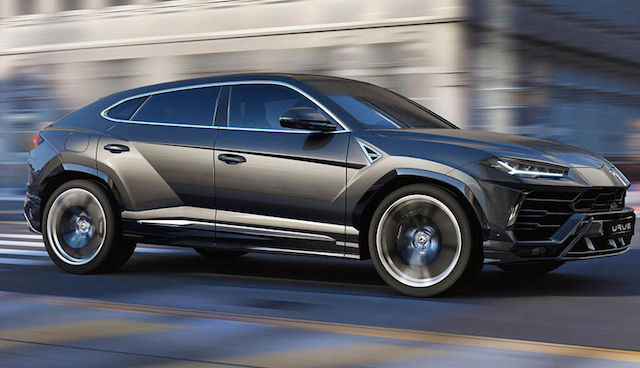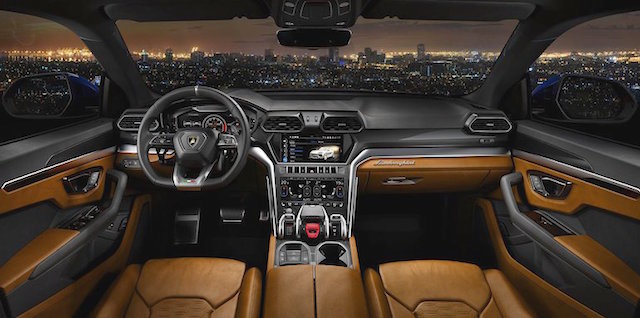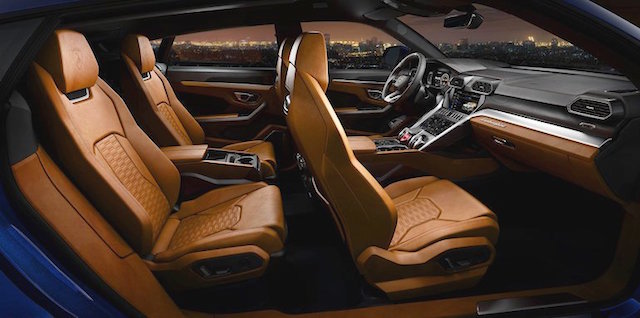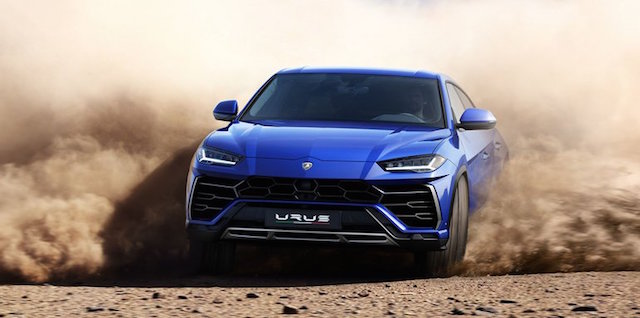
The car Lamborghini claims is the world’s fastest SUV will land in New Zealand next year, priced to compete with the another two-tonne flyer, the V12-powered $350,000 Bentley Bentayga.
The Lamborghini Urus uses a twin-turbocharged 4.0-litre V8 petrol engine delivering 485kW of power at 6000rpm and 850Nm of torque between 2250rpm and 4500rpm, oomph that propels it from 0-100km/h in 3.6 seconds, 0-200km/h in 12.8 seconds, and on to a top speed of 305km/h.
Its eight-speed automatic gearbox is tuned for shorter ratios in low gears, ensuring maximum performance from a standstill. Despite not using a faster dual-clutch setup, the box is said to feature a highly efficient slip-controlled lock-up clutch and specially-developed torque converter for urgent response.
The four-wheel drive system sends 60 per cent of its torque to the rear wheels in normal driving, but can instantly force up to 70 per cent to the front wheels to boost traction.
Equally, it can send 87 per cent of the engine’s torque to the rear if necessary. A range of driving modes, including Strada, Sport, Corsa, Terra (off-road), Neve (snow) and Sabbia (sand), allow the owner to tailor the car’s characteristics to suit the situation in hand. Like in other Lamborghini models, there’s also an customisable Ego setting.
Lamborghini CEO Stefano Domenicali said Urus elevates the SUV to a level not previously possible, the Super SUV. “It is a true Lamborghini in terms of design, performance, driving dynamics and emotion as well as drivable every day in a range of environments,” he said.
“The Urus fits perfectly within the Lamborghini family as a high performance car. It is the culmination of intensive development and passionate skill to create a new breed of bull: a Super SUV that transcends the boundaries of expectations and opens the door to new possibilities, for both our brand and our customers.” A hybrid variant will also be offered.
The SUV’s rear-wheel steering system can adjust the angle of the rears by three degrees. At low speeds, the rear wheels turn in opposition to the front wheels for improved steering response and a reduced turning circle. At higher speeds, the rear wheels steer with the front wheels to improve stability.
Urus weighs 2200kg, sits on a 3003mm wheelbase, and rides on alloys ranging from 21 to 23 inches in diameter. A selection of summer, winter, all-season, sport and all-terrain tyres from Pirelli P-Zero range are available in sizes up to 285/35 for the front, and 325/30 at the rear.
Stopping power comes courtesy of standard carbon ceramic brakes with 440mm discs up front with 10-piston aluminium callipers, and 370mm units at the rear with six-pot callipers.
Other standard features include fully electric front seats, smartphone mirroring for both Android and Apple devices, automatic high beam assist, automated emergency braking, front and rear parking sensors, push button start, keyless entry, electric tailgate, and cruise control.
There’s also a two-screen infotainment system similar to the one used in the latest Audi A8 and A7. The upper screen primarily displays the car setup, entertainment and navigation screens, while the lower screen is used mainly for the climate control system, but is also employed by the data entry subsystem.
Available features include electromechanical active roll stabilisation, adaptive dampers, LED headlights and tail-lights, hands-free tailgate operation, 360-degree camera system, and a 1700W 21-speaker Bang & Olufsen sound system.
The SUV is available with either a three-person rear bench or a two second-row captain’s chairs. With the rear seats up, the boot is rated at 616 litres. When folded down, luggage space increases to 1596L.
Urus – Spanish for a fighting bull – is the second SUV Lamborghini has made. The first was the LM002, a four-door Hummer-type military vehicle powered by the V12 engine from the Countach supercar. LM002 was made between 1986 and 1993. It weighed around 2800kg, had a 290-litre fuel tank, and earned the nickname ‘Lambo-Rambo’.




